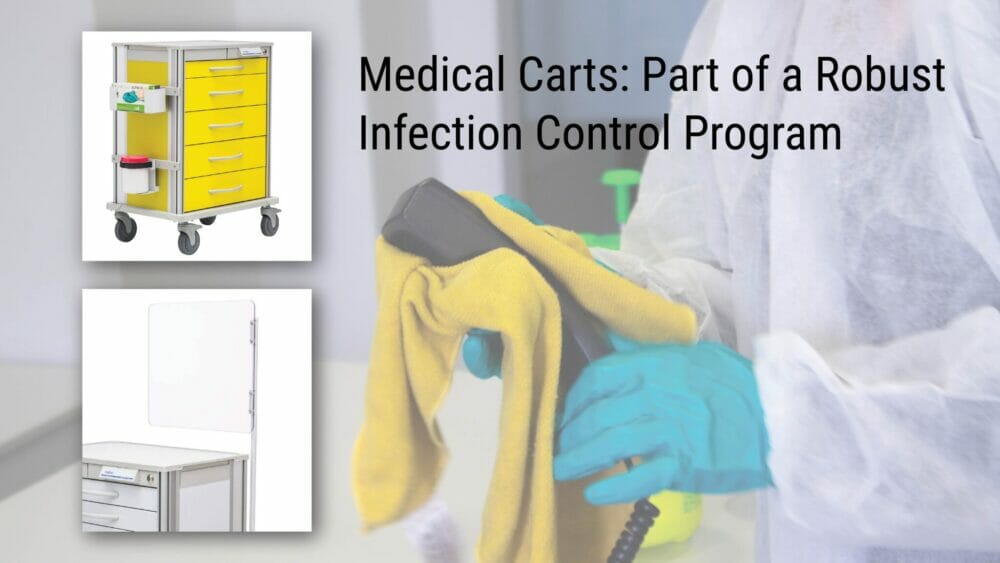
Healthcare-associated infections (HAIs), infections that develop while people are hospitalized for other conditions, continue to drive infection prevention measures in healthcare settings. Mobile medical carts, as part of the patient care environment, play a role in preventing the spread of infections.
HAIs are a public health problem. Each year in the U.S., more than one million people are diagnosed with HAIs. Across the globe, 10% of those patients diagnosed with an HAI die from it.
HAIs are often attributed to medical devices or supplies contaminated with infectious microbes, or by the unwashed hands of staff or visitors. Hospitalized patients with compromised immune systems are especially susceptible to HAIs.
Can healthcare systems prevent HAIs?
Yes, they can, to some degree. The World Health Organization published a report in 2022 showing that 70% of HAIs may be avoidable.
It Takes a Village to Prevent Infections
Preventing infections starts with a robust infection control (IC) program. An effective IC program, as outlined by the Centers for Disease Control and Prevention (CDC), is layered and multifaceted, involving all levels and departments of a healthcare system.
The International Society for Infectious Diseases (ISID) recognizes the patient environment as a factor in the spread of infections. As part of the patient care environment, medical carts may be subject to the facility’s environmental cleaning protocols.
The Joint Commission recommends that facilities focus on four areas of environmental infection prevention:
- Choose the tools and cleaning solutions that work for the setting and are the least toxic to humans
- Establish a protocol for maintaining clean environmental surfaces and for periodic deep cleaning
- Train staff to adhere to scheduled cleanings using the correct solution or chemical for the surface
- Research and, if appropriate, adopt newer technologies that are proven to reduce microbe burden, such as UV lights (to disinfect surfaces), sanitizing mists, and antimicrobial surfaces
A review published in the journal Colloids and Surfaces B: Biointerfaces reported that natural antimicrobial surfaces, such as copper and silver, have been shown to limit the number of bacteria present. Newer technologies that coat the surface or incorporate antimicrobial properties into the surface material may also reduce bacterial load.
Medical Carts as Part of an Infection Control Program
Medical carts are a ubiquitous part of the patient care environment. Mobile hospital carts allow staff to treat patients quickly and efficiently at the bedside. Medical carts can also be a part of an effective IC plan.
When choosing medical carts, inspect your options closely, looking for rounded corners, smooth surfaces, and easy-to-clean removable drawers. Look for optional accessories that help check the spread of microorganisms, such as sneeze guards that protect staff and patients from airborne transmission of pathogens.
Some mobile carts have surfaces made of copper or silver. Others coat or incorporate chemicals into their surfaces that repel or kill microorganisms.
Another feature to look for is the ability to track your carts. In an HAI outbreak, the IC investigative team may need to trace all persons, supplies, and equipment involved in caring for the patients diagnosed with HAIs.
Isolation carts should only be used for patients in isolation and must undergo a thorough disinfection between patients. If a cart is exposed to potentially infectious organisms, such as a blood spill or during a code when bodily fluids may come into contact with the code cart’s surfaces, the cart should be disinfected before the next use.
Keep carts free of clutter. Maintaining an organized medical cart ensures staff can find what they need quickly and reduces the chance that dirty supplies will come into contact with clean supplies.
To ensure that mobile medical carts do not become part of the HAI problem, facilities must establish an environmental cleaning program based on regulatory guidance.
Develop Policies and Procedures
The CDC gives some guidance on establishing an environmental cleaning program that includes all stakeholders:
- Develop a solid relationship between hospital staff and environmental services (EVS)
- Provide ongoing education to EVS staff to ensure the safety of staff and patients
- Choose solutions and technologies that are appropriate for each cleaning situation
- Establish clear and consistent protocols for cleaning and disinfection
- Monitor and evaluate cleaning protocols and EVS performance; reeducate staff as needed
- Collect and share with all stakeholders data on the effectiveness of established cleaning and disinfection protocols
When chosen with infection control in mind and operated under clear policies and protocols that cover stocking and cleaning, mobile medical carts can be a helpful piece of the infection control puzzle.

Cindy Blye
Content WriterCindy Blye, BSN, RN, CCM is a Registered Nurse and Certified Case Manager. She is an Alumni of West Virginia University School of Nursing (BSN), and a member of the Association of Health Care Journalists and The Authors Guild.
